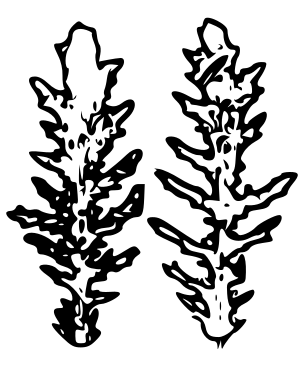York groundsel facts for kids
Quick facts for kids York groundsel |
|
|---|---|
| Scientific classification | |
 |
|
| Range of Senecio eboracensis in Great Britain. |
Senecio eboracensis, also called the York groundsel, is a special flowering plant in the daisy family, Asteraceae. It's a hybrid species, meaning it formed from two different parent plants. This plant is one of only six new plant species found in the United Kingdom or North America in the last 100 years!
Scientists discovered the York groundsel in 1979 in York, England. It was growing right next to a parking lot. They officially described it as a new species in 2003. Like many plants in the Senecio group, it likes to grow in city areas. You can find it in places with disturbed ground or cracks in the pavement. This particular species is only found in York, often between a railway and a parking lot.
Contents
What the York Groundsel Looks Like
The York groundsel is an annual plant. This means it grows, flowers, and sets seeds all within one year. It grows up to about 40 centimeters (16 inches) tall. It has pretty yellow flowers that look like small daisies. These flowers come from one of its parents, a plant from Sicily called S. squalidus. The York groundsel looks different from other similar plants in its family.
Leaves and Stems
The leaves of the York groundsel are large and have many deep cuts or "lobes." These cuts don't reach the middle vein of the leaf. The plant's stems usually stand straight up. Sometimes, the base of the stem might lie flat for a short distance. This flat part can grow special roots called 'adventitious roots'.
Both the upper and lower leaves have a stalk, called a petiole, that connects them to the stem. The upper leaves usually have deeper cuts and appear in pairs. If the plant grows in rich soil or a greenhouse, its leaves can be much bigger. They can be up to 18 centimeters (7 inches) long and 9 centimeters (3.5 inches) wide. The edges of the leaves are usually toothed, which means they have small, sharp points.
Flowers
The York groundsel has flower-heads that are more noticeable than those of its parent groundsel. These flower-heads grow at the very top of the plant in groups. Each group usually has three to seven small flowers, called florets. At first, these groups are dense and leafy. Later, they become less dense as the stalks holding the flowers get longer.
The flower-head is shaped like a cylinder, about 10 millimeters (0.4 inches) long. It becomes slightly bell-shaped when the bright yellow ray florets open. These ray florets are the "petals" that stick out from the center of the daisy-like flower. Like other Senecio plants, the flowers have special parts for reproduction.
Seeds
The seeds of the York groundsel are called achenes. They are about 2.5 to 3.5 millimeters (0.1 to 0.15 inches) long. They are straight and have shallow grooves. The grooves are covered with tiny hairs, but the raised parts are smooth. When the seeds are ripe, they have a silky white, umbrella-like top called a Terminology for Asteraceae#pappus. This pappus helps the seeds float away in the wind, like a dandelion seed.
How the York Groundsel Got Its Name
The name eboracensis comes from the word Eboracum. This was the old Roman name for the city of York. This name was chosen in the year 2000. At that time, scientists were formally describing this new hybrid plant. It had been informally called 'York radiate groundsel' before then.
Where the York Groundsel Grows
The York groundsel grows in places where the ground has been disturbed. You can find it around parking lots, in cracks in the pavement, and other city or industrial areas. It grows specifically near the railways in York, England.
One of its parent plants, Senecio vulgaris, is native to the area. The other parent, Senecio squalidus, came from Mount Etna in Sicily. It was brought to the Oxford Botanic Garden in Oxford, England, in 1690. From there, it quickly spread along railways and throughout the country.
How the York Groundsel Evolved
The York groundsel, Senecio eboracensis, is a hybrid species. This means it formed when two different plant species bred together. Its parents are the Sicilian plant Senecio squalidus (also called Oxford ragwort) and the common plant Senecio vulgaris (also called Common groundsel).
S. squalidus cannot pollinate itself, but S. vulgaris can. Like S. vulgaris, the York groundsel can pollinate itself. However, it doesn't often breed with its parent species in nature. This means it is reproductively isolated. Strong barriers exist that keep this new hybrid from breeding with its parents.
Scientists believe the York groundsel formed when the first-generation hybrid of its parents bred back with S. vulgaris. S. vulgaris is native to Britain. But S. squalidus was brought from Sicily about 300 years ago. So, the York groundsel is a new species that has formed from these two parents within the last 300 years.
Other hybrids have also come from these same two parent plants. Some of these hybrids cannot reproduce. But others can, like S. cambrensis. Scientists use what the plants look like and their genetic information. This evidence supports that S. eboracensis is a separate and unique hybrid.


